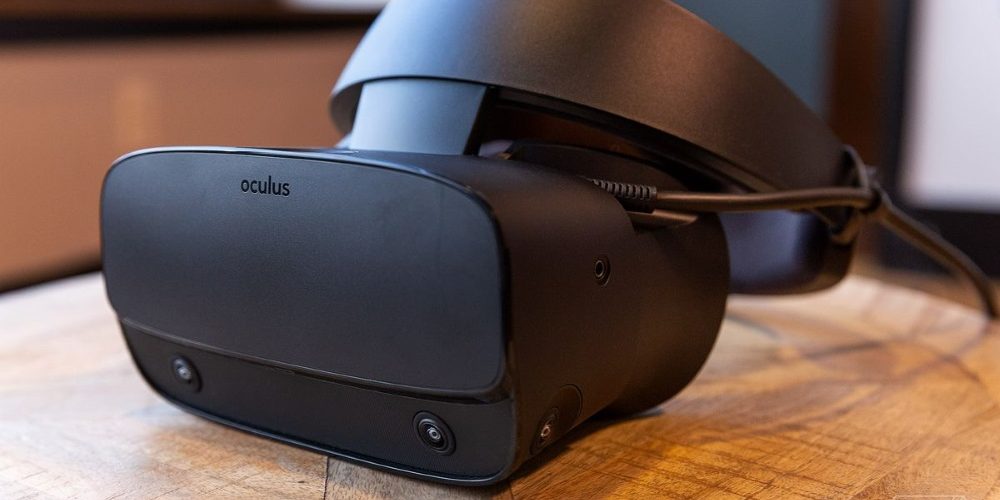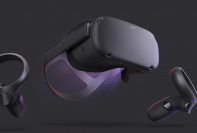It seems unusual to write about a new VR headset by Oculus, just six months after the release of Oculus Quest.
It would seem that any company would let its flagship products grow, before completely stomping on them in exchange for a new champion.
What Oculus has done recently, was completely unexpected and yet also very expected.
It was expected in the sense that when rumors started floating around that the Facebook-owned VR company would be releasing a new VR headset at this year’s GDC event, almost no one thought it was true, because the Oculus Quest had just been released.
It was unexpected because regardless of what we were thinking, Oculus did introduce a new VR headset after all.
The newly announced Oculus Rift S isn’t exactly a revolutionary new product.
It’s not a successor to the Oculus Rift. It is just an upgraded version of it.
During the first day of GDC 2019, Oculus announced the new Oculus Rift S with many of its technical details.
It also lets visitors try out the replacement for the Rift.
The name itself should ring a few bells.
Tech giants, including Apple and Microsoft, use the letter ‘S’ in their products to denote an iterative improvement or upgraded functionality for an already existing product.
For instance, Microsoft’s Xbox One S is an improvement of the Xbox One and the Apple iPhone XS is an improved version of the iPhone X.
The ‘S’ versions are also backward compatible and usually eventually replace the older version completely.
Therefore, you would be correct to assume that the Oculus Rift S has a number of upgrades to the Oculus Rift.
This article lists all of the new features, design changes, performance upgrades, and ergonomics that Oculus has detailed recently.
By the end of this piece, you will be completely up to date with what Oculus has done with the Oculus Rift S and whether or not the new VR headset is worth your investment.
Design
There are a number of differences in the design of the Oculus Rift S, compared to the original Rift.
They make the new VR headset truly worthy of all the resources that Oculus must have utilized to create it.
No More External Tracking Stations
One of the most significant changes in the Oculus Rift is the removal of external sensor stations for tracking.
The headset will instead use cameras placed around the headset, to track the controllers.
Therefore, a great big green flag for the new Oculus Rift S is that it won’t require as many USB ports.
It will be free of the usual hassle of managing and placing external sensors and making sure that someone doesn’t knock them off while you’re playing.
This isn’t just a simple design change, it’s a complete game changer for the entire Oculus Rift experience.
Additional Camera for Tracking
The cameras are an interesting story.
The Oculus Rift S has an extra camera sensor placed at the top of the headset.
This may sound like an unusual spot to place a tracking sensor since users rarely take their hands away from the field of view covered by the original four cameras.
However, Oculus wants to provide its users with the ultimate VR experience.
Many games require movements, where the controller goes out of the usual field of view, like during a sword slashing action.
More Comfortable Halo Strap
Another one of the most significant design changes that will make you want to buy the Oculus Rift S, is the replacement of the original tri-strap with a much more comfortable halo strap.
This strap is much easier to handle.
Its tightness can be adjusted, using a knob at the back of the head.
According to Oculus spokespersons, the new strap design will greatly improve the comfort of the headset and allow the users to wear the headset for even longer periods than before.
Another advantage of the new strap is that it doesn’t leave prominent red marks on your forehead, like the original one used to.
Lenovo has been very successful using this design pattern.
According to Oculus, its partnership with Lenovo has provided valuable assistance in successfully developing the design of the Oculus Rift S.
Not only has Lenovo been helpful in the Oculus Rift S’ design, but the tech giant is also the manufacturing partner for the headset.
Better Weight Distribution
The replacement of the straps has helped Oculus to deliver an even better weight distribution than the original Oculus Rift.
It is important to note that the Oculus Rift S is slightly heavier than the Oculus Rift.
However, the weight distribution that is achieved with Lenovo’s assistance is phenomenal.
The Oculus Rift S actually feels much lighter than the Oculus Rift, when you put it on.
A major reason for the achievement of this remarkable weight distribution is due to the halo strap architecture.
It distributes the weight of the headset across the user’s head, instead of focusing all the weight towards the front, as the tri-strap architecture did.
To make things even more comfortable, you can also adjust the depth of the headset.
You can move the headset in or out in the direction of the face, to make the headset fit perfectly on your head.
An Oculus spokesperson mentioned that the company considered adding a hinge architecture for the Oculus Rift S.
This would rotate the main headset upwards on the strap.
They said that creating a hinge isn’t a good idea for the new Oculus Rift S since it would have greatly increased the cost.
Oculus is working hard to keep the cost of the new VR headset at $399.
The addition of the hinge would have made it impossible for the company to maintain this price.
Since the Oculus Rift S already features a superb Passthrough+ feature that lets you view and interact with your physical environment, the hinge would have been overkill.
Fewer Wires
One thing about the Oculus Rift S that everyone will love, is that the new VR headset doesn’t require as many wires as the original Rift.
Thanks to the removal of the external sensor stations, they won’t be as many wires running around the corners.
There were be less tripping over wires and disconnecting a station.
This makes the VR headset unable to track the user’s motion.
It completely ruins the immersion of the VR experience.
The only thing that you will need is the main cord that tethers the VR headset to the computer.
Better Display Lenses
The Oculus Rift S will also have new and improved display lenses.
Since they are still Fresnel lenses, there will be some god rays.
The new lenses are similar to the ones used in the Oculus Go and Oculus Quest, which means that there should be better results than the Oculus Rift.
Many people are saying that there aren’t any god rays in the new Oculus Rift S.
That is not true Fresnel lenses have god rays.
However, they can be expected to be heavily diminished by Oculus, as they have done in the Oculus Quest.
You should, therefore, only experience prominent god rays in exceptionally high-contrast scenes.
God rays refer to the volumetric scattering of light.
While they are very popular in video games and make in-game landscapes even more epic, physical god rays emitting from the display lenses can be very frustrating.
Software IPD Adjustment Only
The new Oculus Rift S no longer has a mechanical IPD (Inter-pupillary Distance) adjustment system.
This is because the fast-switch LCD display is a single display.
It is not possible to implement a hardware IPD adjustment system on them.
Oculus has, however, added a software-based IPD adjustment mechanism to prevent completely losing this very helpful feature.
The problem with the software IPD adjustment is that while it covers a large range on the IPD scale, it can’t cover as much as the hardware IPD adjustment mechanism can.
Therefore, people with extremely small or extremely large IPDs will need to get creative, in order to enjoy VR experiences on the upcoming Oculus Rift S.
You can use optical lenses or find a frame that fits comfortably inside the VR headset to overcome this obstacle.
Performance
The new Oculus Rift S has several performance upgrades that make the headset even more fun than the original Oculus Rift.
From the Insight tracking system to the upgraded Passthrough+, all of the notable performance features of the Oculus Rift S are described in this section.
Insight Inside-out Tracking
One of the most important factors in any VR headset’s performance is its tracking system.
The tracking system of the VR headset is one of the main reasons why a VR experience can be super-immersive or very frustrating.
There is no need to worry about the tracking system for the Oculus Rift S.
This is because it uses Oculus’ Insight tracking just like the standalone VR headset by Oculus, the Quest.
The proprietary inside-out tracking system uses cameras placed around the headset to track the headset, as well as the movement of the controllers.
The original array of four cameras works brilliantly in tracking the controllers.
However, the addition of the fifth camera greatly adds to the field of view of the Insight tracking system.
With the Oculus Insight, there is an even smaller area behind the user, where the controllers’ tracking cuts off.
Since the tracking sensors are on the headset, the system loses track, if you bring the controllers very close to your face.
This can be an issue, particularly in games where it is necessary to bring the controllers close to the face.
For example, when you try to aim down the sight of a rifle or when you are charging a bow, you may lose the tracking.
After a few attempts, we were able to find the sweet spots in games like these and the controller tracking was then flawless.
Audio
Oculus has taken a step down, with the built-in audio system of the Oculus Rift S.
The upcoming VR headset by the VR giant doesn’t feature the dedicated headphones, like in the Oculus Rift.
However, the built-in speakers work very well.
As a result, you won’t be able to notice any difference.
However, since your ears won’t be completely isolated, outside voices may become a nuisance in crowded areas.
Many hands-on reviewers also mentioned that the sound quality would become a bit tinny when the in-game audio gets louder.
If the built-in audio doesn’t meet your needs, there is a concealed 3.5mm audio jack on the side of the headset where you to plug in a headset of your own choice.
However, based on what we have experienced so far, you are not likely to need a secondary headset to enjoy VR experiences, if you play at home.
Better LCD Fast-Switch Display but Slightly Lower Refresh Rate
The Oculus Rift S features a better display with a resolution of 1280 x 1440 pixels per eye.
This resolution is considerably better than the 1080 x 1200 pixel-per-eye resolution of the existing Oculus Rift.
The fast-switch LCD display featured in the upcoming Oculus Rift S greatly reduces the screen door effect.
However, the new display’s advantages also come at a cost.
Many people who reviewed the upcoming Rift S VR headset, remarked that the LCD display’s colors weren’t as vibrant as the OLED featured in the Oculus Rift.
The contrast in the LCD display is also lower than the current model.
The greatest drawback, for many people, is the reduced refresh rate in the new LCD display.
The Oculus Rift S will have a refresh rate of 80Hz, instead of the 90Hz on the original Rift headset.
This isn’t a huge difference in refresh rate.
However, many gamers are very sensitive about the refresh rate.
This is also the reason why most people are unhappy with the lower refresh rate.
The refresh rate of the Oculus Rift S headset is actually exceptional.
As a result, you can barely notice any difference in the smoothness of the display.
The lower refresh rate is a great decision by Oculus.
This is because it also makes the Oculus Rift S backward compatible.
Computers that are able to power the Oculus Rift headsets, will be able to adequately handle the higher resolution of the Oculus Rift S.
This allows users to buy the new Oculus Rift S and start enjoying their VR experiences, instead of having to invest in a new and more powerful computer to go with the new headset.
Passthrough+
The Passthrough system has also received a serious upgrade in the Oculus Rift S.
The new system (Passthrough+) can now be activated via a toggle option in the menu.
Passthrough is a very useful feature in the Oculus Rift that uses the external cameras to show you your environment directly on the headset’s display screen.
Therefore, you don’t have to take off your headset, every time you want to get something done in the outside world.
This includes things like checking your smartphone for messages or calls, picking up a mug of coffee, walking to someone in the room, and other small tasks that would become a hassle to do, if you had to take off your VR headset every time.
The new Passthrough+ system also has a feature that allows you to mark your play area by virtually painting a boundary around you.
This feature will prevent you from rearranging the whole room, before starting your VR gaming session.
The overall difficulty of setting up the Guardian is also significantly decreased, due to the new Passthrough+.
Those using Oculus Rift S as their first VR headset, won’t remember the frustrating process that was necessary to set up the Guardian, before starting VR gaming sessions.
Pricing and Release Details
Since we have discussed the design and performance details of the Oculus Rift S, we will discuss the launch timeline and the pricing details of the product.
The Oculus Rift S is expected to be launched in the spring of 2019.
Therefore, March, April, and May are the months to remember, if you are interested in buying the Rift S.
The release date is obviously a long stretch since there is still some uncertainty.
It is likely that Oculus will launch the Rift S as soon as possible or as late as possible because, with the Oculus Quest, the standalone VR headset is also set to be launched in the spring of 2019.
Nevertheless, Oculus will be selling them both by the end of this spring.
To make things even more confusing, both Oculus headsets will be priced at $399 at the launch.
It does not make sense to release two products with the same price point.
However, we discussed earlier that the Oculus Quest and Oculus Rift S aren’t the same products at all.
If the two products were from two different companies, we would assume that both the companies were trying to compete with each other in the market.
However, since both the VR headsets are from Oculus, the Quest will be competing with the Rift S.
Our Verdict
The new Oculus Rift S is a much better product than the original Rift.
However, you already know that.
The real question is whether the Oculus Rift S is worth investing $399, especially for people who already own an Oculus Rift.
The answer to that question depends on your priorities.
The Oculus Rift S has several excellent upgrades.
However, they also have several features that could discourage specific people from buying it.
For instance, the software IPD makes it impossible for a very small group of people, with extremely large or very small IPDs, to use the VR headset without fitting spectacles inside the headset or using optical lenses.
Those individuals who are very sensitive to flicker may notice the lower refresh rate in high-contrast scenes.
People might also not like the audio system during loud scenes or when they are playing in a crowded area.
However, despite all these shortcomings, there are several features that make the Oculus Rift S well worth its price.
Upgrades like the new Passthrough+ system, the five-camera inside-out tracking (Oculus Insight), the removal of external sensor stations, better display lenses, a high-resolution LCD display, and the notorious halo strap architecture by Lenovo, outweigh the VR headset’s flaws by a very large margin.
The halo strap architecture and the better weight distribution is enough for me to choose the Oculus Rift S over the original Rift.
The fact that an upgraded version of the Oculus Rift is being launched at a price of $399, makes the Oculus Rift S very likely to be your next most favorite VR headset.




